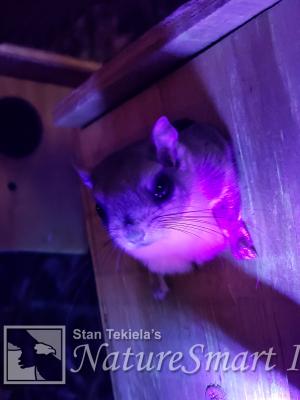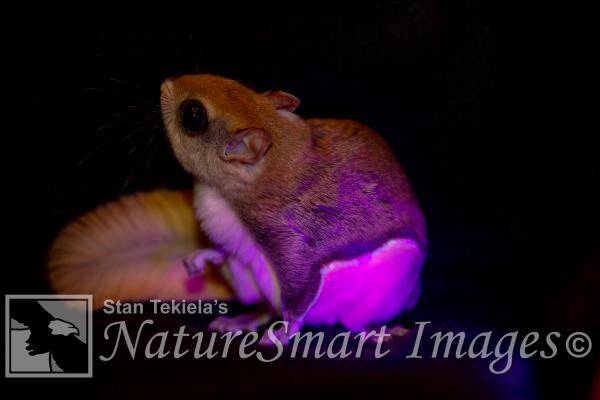View all of the titles in the
NatureSmart Bookstore


by Stan Tekiela
© NatureSmart
April 8, 2019
In this day and age, it is rare to discover a new species of animal. It is not surprising to discover new insects since there are nearly a million species of bugs in the world. On the other hand, there are only about 5,000 different kinds of critters on the planet. So back in 2017 is was surprising when a new species of Flying Squirrel was discovered right here in North America. Well, actually not exactly discovered, more like, separated from the existing known species.
There are 44 species of Flying Squirrel in the world. Nearly all are found in Eurasia / Southeast Asia. Here is North America we have just two species: Northern Flying Squirrel and the Southern Flying Squirrel. However, along the west Coast from Central California through Oregon and Washing and up into British Columbia the flying squirrels looked different from others. They were smaller and darker. So, a researcher started looking into these differences. They used DNA sequencing and discovered this pacific population was distinct from other flyers. And just like that, a new species was discovered. A new species hiding in plain sight. It is the 45 flying squirrel species. It was named the Humboldt’s Flying Squirrel after the German naturalist Alexander Humboldt from the late 1700’s.
Recently flying squirrels have made it into the news again. This time for something very different but yet again hiding in plain sight. A biologist at Northland College accidently discovered that the white bellies of flying squirrels shines bright pink under ultraviolet (UV) light. This is known as fluorescing.
A friend of mind recently contacted me to see if I had seen this new study. I hadn’t, so googled it up, and low and behold I read about this crazy phenomenon. At first, I thought, this is not surprising since most things that are white will glow blueish under UV light. So, I had to see this for myself.
I grabbed my super cool uvBeast (UV) flashlight which is an 18-watt flashlight with 100 LED diodes and gives off a beam of UV light. I also have a captive flying squirrel and so I dimmed the room lights and turned on the uvBeast. Instantly I could see the belly of my flying squirrel glowing a bright pink. I was shocked and amazed at how bright pink his belly appeared in the UV light.
Now the question is, why do the bellies glow pink under UV light? Of course, we don’t know and right now everything will be speculation. Some are suggesting that it is for mate selection. Well, I think this theory doesn’t even start since both male and female bellies glow the same color. Some believed it helps the squirrels avoid predators. I would have no idea how this might work and find that hard to believe. The problem I have with all these guesses are, flying squirrels are nocturnal and become active well after sunset. There is no UV light at night so I am not sure how the pink shinning belly would help.
Flying Squirrels are amazing little animals. They are omnivorous and eat everything from fruit and seeds to leaf and flower buds along with fungi. They are also large consumers of insects and other things such as bird eggs and baby birds.
Of course, they can’t really fly but rather they are experts at gliding. They have a flap of skin, called a patagium, that stretches between their wrist and ankle that acts like a furry parachute. When they begin to glide, they spread their front and hind legs, forming a square shape. A small cartilaginous wrist bone, which is only found in flying squirrels, extends out and changes the tautness of the patagium. They also have a fuzzy flat tail which acts like a rudder and helps with balance.
The last couple of nights, I take my uvBeast (UV) flashlight outside and watch the wild flying squirrels at my house gliding around in the darkness. I must say, it is very strange to see hot pink squirrels gliding through the jet-black sky at night. If you have any questions about getting your own uvBeast (UV) flashlight give me a shout. Until next time…
Stan Tekiela is an author / naturalist who travels the U.S. to study and photograph wildlife. He can be followed on www.facebook.com and twitter.com. He can be contacted via his web page at www.naturesmart.com.
The nationally syndicated NatureSmart Column appears in over 25 cities spanning 7 states: Minnesota, Wisconsin, Michigan, Illinois, Ohio, New York and Pennsylvania. It is a bi-weekly column circulated to over 750,000 readers.
Wolves
Just the day before, a pack of wolves known as the Wapiti, had found a large bull bison that was weak and injured. Based on its size, this big boy was near the end of its lifespan and the winter weather was taking its toll. For a full day the wolves tried to approach the bison but when the bison...
Moose
It was one of those dark and cloudy winter days in Yellowstone National Park where the clouds are so heavy and low, you feel like you can reach up and touch the cloudy sky. A light wind helped to blow the falling snow with occasional gusts of wind causing swirls of fluffy white snow...
American Badger
It’s funny, I believe the average person knows more about the Honey Badger (Mellivora capensis), a critter of Africa and Southwest Asia than they do about the badger in our own backyard, the American Badger (Taxidea taxus). Social media has a lot to do with the Honey Badger phenomena and...
Backyard Bird Feeding
Winter bird feeding is one of the most common / popular hobbies in America. It is estimated that nearly 60 million Americans feed birds in their yards in winter or summer. That is about 40 percent of all American’s make backyard bird feeding part of their everyday activities. It’s...
View all of the titles in the
NatureSmart Bookstore
Check out Stan's latest photos at
NatureSmart Wildlife Images
Take a tour with Stan.
» More Info
Hear Stan on radio stations all across the Midwest.
» More Info

When he's out in the field, Stan relies on his Vortex Razor binoculars and Vortex Razor spotting scope to help find the subjects for his award winning wildlife photography.

For thirty years, professional wildlife photographer Stan Tekiela has counted on Hunt's Photo and Video to provide him with professional photography equipment.
From tripods to camera bodies and lenses, Hunt's has been Stan's place for everything that he needs. Personal service and prompt shipping means Stan can count on Hunt's to support his professional wildlife photography career.


Professional Wildlife Photographer Stan Tekiela always uses Feeder Fresh in his seed feeders to help keep the feeders and food dry, clean and mold free.
He also uses Feeder Fresh Nectar Defender in all of his hummingbird feeders. It safely keeps nectar fresh longer.